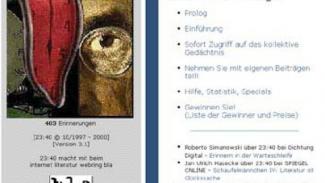23:40 ist ein Schreibprojekt, in dem es darum geht, die 1.440 Minuten eines Tages mit Erinnerungen zu füllen. In der Einleitung heißt es: „Welche Erinnerungen haben Sie an bestimmte Zeitpunkte? ...und die anderen? Finden Sie es heraus! Halten Sie es fest!“ Ob es sich bei den Texten um Erinnerungen an eine bestimmte Minute handeln soll oder um Erinnerungen in dieser bestimmten Minute oder einfach um Erlebnisse in dieser Minute, die erst durch das Aufschreiben zum Erinnerungsstoff werden, lässt der Initiator offen. Klar festgelegt sind indes Umfang des Textes (max. 200 Wörter) und die Zugangsmöglichkeit zu ihm: nur in jener Minute des Tages, für die er geschrieben wurde, und dann natürlich nur für genau 60 Sekunden.
Dieses raffinierte Konzept hat mehrere Konsequenzen: Das Projekt verweigert die jederzeitige Verfügbarkeit der Texte. Man muss lange warten und möglicherweise seine Schlafenszeit verschieben, bis ein bestimmter Text erscheint, und man ist gut beraten, dann keine weitere Zeit beim Lesen zu verlieren (oder eben den Text runterzuladen, ehe er wieder verschwindet). Während die Schrift in Printmedien immer eine Situationsentbindung markiert, so kehrt hier der zeitliche Verlautbarungsanlass zurück. Dies ermöglicht, die Rezeption eines Textes an die Zeit des Erzählten zu binden. Die Beschreibung der Nachteinsamkeit liegt dann sinnvollerweise in den Nachtstunden. Die zeitliche Festlegung der Textpräsentation ermöglicht aber auch solch bemerkenswerte Effekte wie in Minute 9:19, in welcher der gleiche Autor, der in Minute 09:18 eine Todesnachricht erhielt, nun durch eine nur drei Wörter umfassenden Text seine Leser zu einer Gedenkminute veranlasst.
Wie jedes Schreibprojekt lebt auch 23:40 vom Leser-Autor-Rollentausch. Der Clou ist, dass die erschriebene Ewigkeit eine anonyme ist, denn an der Stelle der Autorennamen steht nur die genaue Uhrzeit. Dies ist freilich insofern konsequent, als die leere Minute mit ihren nicht überspringbaren 60 Sekunden ja zum Schreiben animierte, und damit Anlass, wenn nicht gar Autor des resultierenden Textes ist (so wie John Cage Autor des Klavierstücks 4' 33'' bleibt).
Guido Grigat’s 23:40 – das kollektive Gedächtnis (“23: 40 – The Collective Memory”) is a prime example of Second Generation Hypermedia in that it takes advantage of the Internet’s communicative possibilities. It is a prototypical collaborative hypertext in that it gives full authorship to its ‘wreaders’, who may post their contributions directly to the website. Their lexias subsequently appear as part of an ever-changing hypertext clock, which changes its lexias every minute, displaying the contribution which has been appointed to that particular time.
Unlike other collaborative hypertexts, 23:40 has been in operation since 1997 and is still inviting contributions from readers who understand the German language. To contribute, users simply write their texts into the box provided, also stating the exact time at which they wish it to appear. The texts are posted like an email and promptly published.
Roberto Simanowski ("Die Ordnung des Erinnerns. Kollektives Gedächtnis und digitale Präsentation", 1999) reviews 23:40 in comparison with a similar hypomnetic work, Jan Ulrich Hasecke‘s Das Generationenprojekt, which, pursuing a ‘bottom-up’ historical approach, invites ‘wreaders’ to contribute their personal accounts of historic events that happened in 20th century Germany. In another publication, Simanowski discusses 23:40 as one of the three most representative collaborative writing projects in German collaborative hypermedia, the other two being Beim Bäcker, which discontinued to invite contributions in December 1998 and is therefore not included in this canon, and Alvar Freude and Dragan Espenschied’s Assoziations-Blaster. Simanowski remarks that, in 23:40, the author collaborates with the programme. In fact, the programme “instructs the reader to become an author, it occupies the author’s name, and it creates, together with the author, the deeper meaning of the text” ("Death of the author? Death of the reader!", in: p0es1s - The Aesthetics of Digital Poetry, ed. by Friedrich W. Block et al. Berlin 2004, p. 89). Grigat himself assumes the function of programmer-editor, leaving the major aesthetic efforts up to his contributors.
Whether or not Grigat’s self-evolving hypertext is of high aesthetic value, from a poetic point of view, is open to question, mostly because of the plurality of its writers and their equally pluralistic approaches to poetic expression, which in some cases appears entirely prosaic, in others poetically overstructured. That said, the text draws its wide appeal among readers and users less from textual and writerly authority than from the mere fascination it arouses in participants about the possibility of actually becoming a wreader and partaking in a shared, creative written event. The project is innovative and, more compellingly than most other hypertexts, implements the idea of true multiple authorship and the ‘empowerment’ of the (w)reader.
This entry has been adapted from Astrid Ensslin: Canonizing Hypertext: Explorations and Constructions. London: Continuum 2007, pp. 93-94.
